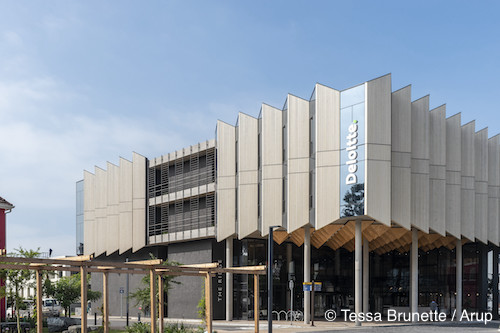
What is the best approach to simulating geometrically complex buildings? Many building performance modeling tools can’t handle solar gains and self shading correctly, or have other geometric limitations.
-Not Always Right-Angled
Dear Not Always Right-Angled,
A medium-famous architect once commented: if it’s not a right angle it’s a wrong angle. As square as that approach may seem, it did make modelling slightly more straightforward than with some of the geometrically complex creations we see in vogue now.
For better or for worse, complexity has made our days as building performance modellers more challenging. And our nights longer. It’s worth stating from the outset that all our models are estimations, and we introduce layers of simplifications in various places in every model, both in the geometric representation itself, as well as in the analyses. This is the case whether geometrically complex or straightforward. It’s just that with geometrically simple models, we’re forced to think a lot less about what can be simplified in order to perform a simulation.
Here I offer some general tips that can help navigating modelling complex geometries.
Keep it simple, stupid
Borrowing a phrase from Kelly Johnson, the best advice is to keep it simple stupid (KISS). We want to simplify the geometry as far as possible, but often the primary challenge with geometrically complex spaces is simplifying the geometry in a way that makes sense in the physics. Before we can think about doing this, we should understand the aim of the study we are performing, as different studies may favour different simplifications.
Some questions to ask are: what is the expected outcome, what metrics are being used to form the assessment, how precise is precise enough? Answering these can help to give some steer to approaches for approximating the geometry of the study appropriately. In general, we’re trying to understand the physics, and what are the key geometric factors that drive this.
For example, the spatial position of apertures is important in a daylighting study, but may be much less so in a solar gains assessment. So a simplification that lumps similar apertures is reasonable for the latter, but not the former. The daylighting study may be better tackled by studying representative areas with more detail, and extrapolating to other areas of the building (but with no more detail than the grid can capture!).
Be in the ballpark
It is always important to sense check the results we get from simulations (“click and collect” is no good for building performance simulation). This is even more so with complex geometries that have been simplified, as it’s possible that we have introduced a simplification that does not work with the physics, or invokes a limitation of the chosen software tool.
When deciding on how to model a geometry, avoid decisions that would preclude checking an analysis by hand. Hand calculations are a great way to understand, approximately, where we anticipate a result to land. In this way they are an indicator. They are typically relatively simple and easy to interrogate, so that if the results of our simulation are at odds with our hand calculations, it would suggest that our simulation assumptions need further probing.
Another good tool for building model confidence, is to use “shoebox models” to test geometric simplification. These are small, very simplified models that can be run as sensitivity checks for many of the assumptions in our complex models. For example, we typically rationalize curved surfaces as a series of planar facets, but there is a question of how many facets is sufficient? Shoebox models testing different numbers of facets can help determine the point at which additional facets no longer improve the quality of the assessment.
Know the software
Finally, not all simulation software is created equal. For complex models especially, because the geometry may be well outside of the software’s test-validated scope, it is important to be sure that the chosen software can capture the physics we’re trying to simulate. For example, it may be important that shading elements shade diffuse radiation. Does the chosen software account for that, or does it shade direct radiation only?
The key here is to know the drivers for the assessment and always consult your software package’s documentation to understand these implications.
While there is no one size fits all approach to modelling complex geometries, these steps will set you off on a good path. Whatever the case, the chances are someone else has already encountered it, so make good use of the brilliant community and resources available online and happy modelling those curves and sawtooths!
Adam Ozinsky
Environmental Designer, Atelier Ten (writing in his personal capacity)
adam.ozinsky@atelierten.com
Do you have anything to add or your own answer to contribute? Please share your thoughts by emailing askamodeler@ibpsa.us; you are an expert too! Do you have your own question for the expert? Submit your question to be considered for a future column. Note that questions requiring an immediate response should be submitted to the community of experts at unmethours.com. If you are interested in replying to a question as a featured expert or have any other feedback about Ask a Modeler please email askamodeler@ibpsa.us.


